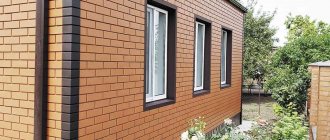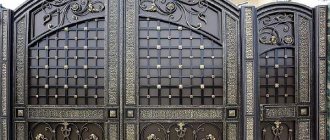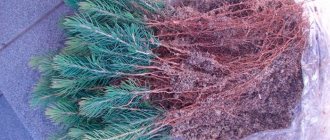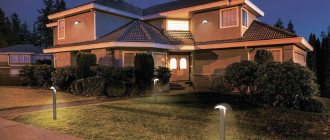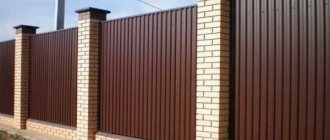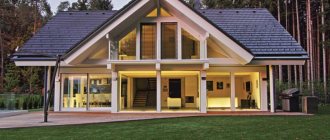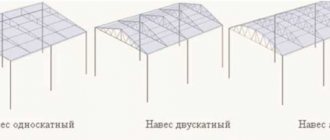For many, flat roofing is associated with urban multi-story buildings, faceless and monotonous. But we are ready to surprise you! A flat roof in a private house will be a pleasant discovery for you if there is not much snow in your area, but the winds are quite strong. The fact is that in winter all snow accumulations from such a roof will simply be blown away. And the main thing is that not a single strong hurricane can tear off a roof that simply does not exist! And a whole ocean of possibilities opens up before you, which you can now build above your head: a cafe, a dance floor, a mini-garden and even a whole greenhouse!
The main thing is to know about all the intricacies of constructing houses with a flat roof, and everything will work out. And now we will reveal all the secrets.
Pros and cons of this design
Here are the main advantages of installing a flat roof for a private home:
- Such a roof is much smaller in area than the most gently sloping roof. And this means savings on materials.
- Such a roof is built much faster than a gable roof, and even more so a hip roof.
- Comfort and safety of all rafter work. You still have to manage to fall from such a roof!
- Convenient subsequent repairs and replacement of roofing.
- Unlike a gable roof, dismantling the old flat roofing is usually not necessary - this is additional waterproofing and protection. The new pie is made directly from the old one, which saves a lot of time and effort.
- The ability to use the roof as an additional useful area where you can plant a flower garden, make an open terrace and even build a greenhouse.
- The ability to install transparent roof elements (with careful waterproofing), and thus create a view of the night sky.
- Opportunity to build a house with a laconic architectural form. Minimalism is at the peak of fashion!
And now – about the pros and cons:
- Such a roof generously accumulates snow. After all, he now has nowhere to slide, and the snow itself often becomes the cause of leaks.
- On especially generous days, the snow will have to be removed mechanically, which often damages the roofing.
- The structure of the roof becomes more complicated: now we need gutters, which also become clogged.
- The difference is that water drains from a pitched roof quite quickly (and sometimes it does get into the under-roof space). But on a flat one it actually stands! Monitoring the moisture content of the insulation and the general condition of the roof should be regular.
- But, despite the fact that much less building materials are needed for its arrangement than for a pitched roof, a flat roof is much more complex in terms of installation. Let's just say that there are many more different subtleties and nuances that are important to know about.
That is why many have fair doubts about the reliability of such a roof. But the European and overseas experience of private residential buildings with a flat roof is successful, and therefore you can safely get down to business.
Just consider these points:
- There is much more snow in Russia than in warmer European countries.
- The only thing worse than snow is the large difference between summer and winter temperatures, which not all foreign roofing materials are designed for.
And here technology decides everything!
Autonomous cottage of 36 m², which can be assembled in 2 days
- Brazil
- 36 m²
- SysHaus
- 1
- made
The net-zero LilliHaus prefabricated house from SysHaus is completely ready for installation. Its design is suitable for life on both land and water. The authors of the project call the cottage a plug-and-play module, which literally translates as “turn on and play (work).”
The new LilliHaus has dimensions of 3 x 12 m. The house is completely autonomous, although if necessary it can be connected to local communications. Solar panels generate energy, which is stored by a battery (12 or 110 volts). Black and gray wastewater is treated in a local wastewater treatment plant (WTP). At the exit, the waste is converted into methane and water. The resulting water is so pure that according to Brazilian regulations it is allowed to be discharged into the natural environment. Let’s make a reservation that in Russia, water from septic tanks with biofilters is allowed to be discharged directly onto the terrain. As for reservoirs, different rules apply here. Even after VOC, which purifies water 95% biologically, wastewater can only be discharged into water bodies in agreement with the SES after additional treatment, for example chlorination and ultraviolet disinfection (more details here). For drinking, the developers propose using river water passed through a high-tech, multi-stage purification system.
The module is delivered to the site completely ready and, after delivery, will be ready for use within two days. The house kit includes all the furniture and equipment
Read more in Plug and Play.
5
What is a flat roof?
So, what acts as the load-bearing base of a flat roof:
- Reinforced concrete slab.
- Roofing sandwich panels.
- Reinforced steel corrugated sheet.
And thanks to the fact that they learned to make a flat roof “breathable”, i.e. with internal ventilation, it has now become possible to use completely non-breathable waterproofing - roofing felt similar to it.
Any roof that we call flat actually still has a slight slope: to one side or specifically towards the drainpipe.
Here is the simplest example of a flat roof for a private home:
Advantages of a flat roof
Many people are accustomed to certain forms of house construction and therefore the popularity of the sloped roof. However, it should be noted that more and more people are beginning to appreciate the benefits of a flat roof , and there are quite a few of them.
Wind resistance
This solution turns out to be practical and aesthetic. There is no chance that a hurricane wind will break through the surface of a flat roof, but in the case of pitched roofs, such a threat is quite real. In recent years, we have been hearing more and more alarming information about roofs being torn off as a result of strong winds. Due to the weather anomalies occurring in our country, including unprecedented wind strength, it is worth considering the use of a flat roof that is so resistant to wind pressure.
Reduced heat losses
A well designed and manufactured flat roof can largely eliminate heat loss through the upper external baffle, which is possible due to the reduced external surface area in relation to the sloped roof being kept to a minimum.
Types of flat roofing: non-exploitable and inverted
Of course, unused roofs are cheaper. And the exploited ones, which are correctly called “inversion”, include additional materials.
A separate type of flat roof of a residential building is exploitable. Those. the one on which people will walk and what objects will stand. This is the same garden, or sports ground, or summer cafe. All this creates considerable loads on the roof, and therefore its design is already different from that which is intended only to protect the house from precipitation.
So, the main difference in the design of traditional and inversion roofing is that in the first, the thermal insulation layer is located under the waterproofing, which is quite logical, and in the second, it is above it. But in the second option, the waterproofing is more protected from ultraviolet rays and temperature changes. This design is more durable and functional: you can safely lay out a lawn or lay paving slabs on it.
And now in more detail.
Unused roof: standard pie
But a person can also occasionally climb onto an unused roof - for the same repairs, for example.
Those. in a traditional flat roof, the top layer is waterproofing, and it is this that is exposed to all mechanical and temperature loads.
A separate type of it is a roof with a pressure layer, which is designed so that a person can walk on it from time to time:
Inversion roofing: reverse pie
The standard slope of an inversion roof is 5-7%. The inversion method assumes that the thermal insulation layer is already placed on top of the waterproofing, which now also serves as a vapor barrier.
Moreover, the pie of inversion flat roofs can be very different. It all depends on what you are going to arrange on the roof: a terrace, a mini-pool (and this is not uncommon) or a garden. But the base will still be common: a monolithic screed is made, which levels the entire surface, then waterproofing is laid and the whole thing is covered with insulation. And on top is a cement-sand mixture or rubber coating.
Note that active use of the roof means frequent damage to the insulating layer, which is why moisture makes its way to the insulation and freezes in winter. Over time, the entire roofing pie deteriorates, and therefore a flat roof cannot do without a ventilation system.
A cement-sand screed can even better distribute the pressure layer on the heat insulator, but it must be additionally reinforced with a mesh to prevent cracking.
Varieties and distinctive features of different types of roofs
In modern private housing construction, there are several ways to arrange a flat roof, which have some differences in the order of layers and the composition of the roofing pie.
Traditional roof
The composition of a traditional flat roof (also called soft), regardless of the slope, includes several layers:
- Base . Usually this is a reinforced concrete slab or metal profile structure.
- Vapor barrier . It is laid directly on the base and protects the overlying layer from diffuse moisture penetrating from below. The layer is made of roll or bitumen materials.
- Thermal insulation . The insulation is often one or two layers of mineral wool, polystyrene foam boards or PIR boards. It is acceptable to use expanded clay gravel or install a cement screed.
- Waterproofing . Protects underlying layers from atmospheric moisture. To organize it, bitumen-based materials are used: various rolled materials, as well as mastics or PVC membranes.
Installation of traditional roofing Source projject.ru
- Finish coating . Its role is successfully fulfilled by modern brands of waterproofing materials. The use of sheet and piece materials is not recommended - a small slope and many joints create a high risk of leaks.
See also: Catalog of companies that specialize in roof repair and design.
Operated roof
The main advantage of this design is the opportunity to obtain and profitably use additional space, in the form of a cozy relaxation corner or a place for sports. The design is a multilayer structure, the characteristics of which are prescribed in SNiP. The rules describe the procedure for arranging a roof in use; A cross-section of the pie with dimensions can be studied there. The operating coating has the following differences from the traditional design:
- A slope-forming layer is laid above the reinforced concrete base .
- Between the layer of insulation and waterproofing, a screed is made (at the correct angle) or fiberglass is laid.
Pie with tiled coating Source tupikov.ru
- Between the layer of waterproofing and the final (finishing) coating, an additional layer of protective separator (layer of geotextile) is made.
Taking into account the peculiarities of use, the layers of the roofing cake are arranged in accordance with the following conditions:
- Base . It must be rigid and capable of maintaining the integrity of the waterproofing.
- Insulation . The thermal insulation layer in such a roof is under constant load, both dynamic and static, therefore, the main requirement for this layer is to have sufficient compressive strength. If the material is not rigid enough, it is reinforced with a layer of cement screed. One of the modern solutions is PIR boards. They are rigid and strong enough to withstand the loads during operation and at the same time light, which allows them not to overload the roof structure.
- Finishing . The most popular option for finishing material is paving slabs, which are installed on special stands or a sand cushion, which allows the pressure to be distributed more evenly. If it is expected that the operation will be significant, experts recommend installing an inversion-type flat roofing pie.
Subtleties of flat roof insulation
A layer of thermal insulation for a flat roof is mandatory. For comparison: a gable roof is insulated only when a residential attic is installed underneath it, and in all other cases, a maximum of mineral wool is laid on the attic floor. But for a flat roof, insulation is always necessary.
The fact is that without a heat-insulating layer in a flat roof, condensation will constantly appear on the ceiling in the house (such a roof will turn out to be the cold part on which water vapor will rush). And this is bad not only because repairs will have to be made, but also because the entire structure deteriorates.
You can insulate a flat roof both from the outside and from the inside - the difference is small. What is more important is how many layers of insulation a particular roof needs – one or two.
Thermal insulation materials must be attached to the base of the roof mechanically, either with screws or dowels, or with adhesive. Sometimes the fastening is not used at all if the heat insulator is located outside and paving slabs or pebbles press on it.
Why two layers? The fact is that the first layer of thermal insulation on a flat roof acts as insulation; it is from 70 to 200 mm thick. And the second, from 40 to 50 mm, is designed to distribute all the loads. And it is important to calculate the thickness of both layers accurately, based on the climatic characteristics of the area and the future use of the roof itself.
With double-layer insulation, all joints should be spaced apart, in a checkerboard pattern, so as not to overlap each other. Moreover, in the places where the slabs adjoin the walls and parapet, it is additionally necessary to make heat-insulating sides. A cement-sand screed can even better distribute the pressure layer on the heat insulator, but it must be additionally reinforced with a mesh to prevent cracking.
Video description
About green roofs in the following video:
- A layer of insulation is laid ; It is appropriate to use extruded materials here.
- Geotextiles are laid (or better yet, two layers, with a profiled membrane between them, which will allow soil pressure to be more evenly distributed).
- Drainage layer . Gravel or crushed stone is used.
- A filter layer that simultaneously protects the root system of plants.
- Soil and green spaces.
Green roof design diagram Source stroyfora.ru
Green roofs, depending on the nature of operation and the amount of landscaping, are divided into two types:
- Extensive . Not designed for constant human presence. The soil layer is laid thin in thickness (up to 15 cm); Only lawn grass is sown, and flowers and ornamental shrubs are planted in pots or special containers.
Extensive green roof Source pinterest.co.uk
- Intense . If the design of the house allows you to lay a layer of soil 0.3-0.6 m thick (the total thickness of the roofing carpet reaches 1.2 m), you can set up a full-fledged garden with trees and lush flower beds on the roof. The installation of such a structure should be entrusted to professionals; Repairing a green roof made by hand is a time-consuming, problematic and expensive task.
Proper drainage system
But this is already a difficult task. Flat roofs are just bad because they are completely open to rain. But everything can be solved! The main thing is to properly organize the drainage, and for convenience, we have explained this issue for you in the following schematic illustrations:
Warm hut 66 m² with green roof
- USA
- 66 m²
- Prentiss Balance Wickline Architects
- 1
- frame
The cottage was built according to the design of Prentiss Architects from Seattle for a small family. One of the main goals was to position the house in such a way that its inhabitants could enjoy the beauty of nature and feel like the only inhabitants of the island, forgetting about the existence of neighbors.
The cottage is a frame structure with a pitched green roof, set on a concrete foundation. Inside there is a kitchen-living room, a bedroom and a bathroom. The house also has a small basement with a laundry and storage area.
Despite the vagaries of nature, the temperature in the hut is always comfortable. It is provided by thermal insulation of the walls and roof with a thickness of almost 20 cm, as well as triple glazed windows installed in windows facing north.
The facade is covered with cedar wood, which looks harmonious with the surrounding landscape and does not require any maintenance
Read more in the material "Eagle's Nest".
7
Internal ventilation device
Another important point when arranging flat roofs is ventilation. The fact is that if moisture accidentally gets into the insulation, it no longer evaporates - it only accumulates. As a result, the heat-insulating material rots and the waterproofing swells. And there are many reasons for leaks: damaged waterproofing, mechanical damage to the top layer of the roof, cracks and damage from frozen water.
A wet thermal insulator is also bad because it causes bubbles and cracks to appear on a flat roof in the summer heat - all due to the active evaporation of water. As a result, the roof covering also collapses. And if moisture gets under the old screed over time, then the entire roof begins to peel off. This is why a flat roof must “breathe”.
For this purpose, so-called aerators are used. They look like simple plastic or metal pipes covered with umbrella caps. They should be located evenly over the entire roof area, preferably at its highest points. The essence of this mechanism is that different pressures are created inside the roof and the air begins to create currents, simultaneously taking with it all the excess moisture vapor.
In practice it looks like this:
In addition, in any living space, water vapor rises up to the ceiling. Moreover, they often successfully overcome this barrier (the water molecule is very small) and end up in the insulation, which is bad for it. This is why vapor barrier is required. And not the kind that is usually used for attic insulation, but a dense one, made of high-quality polypropylene or polyethylene. The bitumen membrane is even more reliable.
Warm cottage 30 m² with mezzanine
- Sweden
- 30 m²
- 1
- frame
The cottage in question is located in Sweden. Its area is only about 30 m² (living area - 21 m²). Despite its compact size, the home turned out to be very light and spacious due to the gray and white decoration, a large number of windows and high ceilings.
Upon entering the house, you find yourself in the hallway. Let's make a reservation that when building small houses, as a rule, they save money on this room and organize the main entrance in such a way that through it you immediately enter the living room. The hallway is not large, but we managed to carve out space in it for a built-in mini-wardrobe and a small niche with a hanger and shoe rack. To the left of the entrance there is a bathroom with a shower. Most of the area was allocated for the kitchen-living room, from where you can go out to the courtyard and terrace. The second tier of the house (mezzanine) is occupied by a bedroom - a large bed, a shelving unit, a tall wardrobe and two wicker baskets with a lid, which act as bedside tables.
A terrace with wooden flooring can serve as a summer dining room in the warm season
Read more in the material “Cubic Equation”.
6
Choosing a suitable roofing covering
So, what is used as a coating for such roofs?
Option #1 - bitumen and polymer-bitumen materials
Such roofs are the least expensive for owners of private houses. We are mainly talking about roofing felt and euroroofing felt. These are rolled roofing sheets, the base of which is synthetic fabric, and the sides are bitumen. As an elastic and frost-resistant material, bitumen serves as excellent protection and waterproofing.
Moreover, laying bitumen roofing on a flat roof is absolutely simple; you only need a gas burner. The rolls are easily fused together.
But such a roof has a significant drawback - fragility. And another thing is that roofing felt does not breathe at all, i.e. It is vapor-tight, and therefore it is necessary to arrange ventilation for such a roof, unless you want the insulation to rot within a year:
Option #2 - liquid rubber
Such roofs have the great advantage that they do not contain any seams. As we have already said, the disadvantage of a flat roof is, first of all, that snow accumulates on it, which then causes leaks.
But there are some subtleties here. So, you need to take only two-component liquid rubber for a flat roof, preferably the highest quality one. And it is extremely important to apply this material correctly to a flat roof: evenly, avoiding unnecessary layers and saving in certain places. So, where the paint was applied unevenly, problems should be expected within 8-10 years.
Option #3 - PVC, TPO and EPDM membranes
Roofing membranes are valuable as a covering for flat roofs because they allow steam to escape. After all, no matter what kind of vapor barrier is used, moisture still, at least a little, gets into the insulation, not only from below, but also from above - after heavy rains, for example.
There are three types of membranes for installing such a roof: TPO, PVC and EPDM. The most popular is PVC membrane, which is also the most flammable. An EPDM membrane is more durable and affordable, but if mechanical damage occurs in it, nothing can be done to fix it, whereas a PVC membrane can only be melted with a hairdryer. In addition, the joints of the EPDM membrane must be glued with a special tape, which is much less reliable than soldering PVC sheets.
But the cheapest membrane in its sector is PVC. But it has such significant disadvantages as low resistance to ultraviolet rays and fear of contact with bitumen, various oils and even polystyrene foam, otherwise the service life will be significantly reduced.
Gluing EPDM membranes requires professional skills. TPO membrane, like PVC, is also welded with hot air. The best is not afraid of ultraviolet radiation, is more chemically resistant and can be laid directly on polystyrene foam or an old bitumen roof without geotextiles. But its service life is shorter than that of EPDM, so for installing a flat roof on a residential private house, we recommend using a PVC membrane.
So, a flat roof device with a PVC membrane is traditionally made like this:
- Step 1. We arrange a monolithic floor slab.
- Step 2. Place a tear-resistant vapor barrier film.
- Step 3. We make a bend from insulation or screed.
- Step 4. Place insulation. In private construction, this is usually 35-density foam, and on top is 50 mm XPS, which is even stronger.
- Step 5. Now geotextiles, 300-500 g per square meter.
- Step 6. Let's move on to waterproofing - this is a PVC membrane. The insulation density is enough to allow walking on such a roof. But, if you plan to make an open terrace on the roof, then you need to continue the pie further.
- Step 7. Lay the geotextile again - now directly on the membrane. We lay rubber tiles or reinforced screed 5-7 cm, on which we already lay paving slabs. To make a screed, you need ballast.
And such roofs are made of rubber, polymers or even foil. Unlike bitumen, they are durable, fire-resistant and adhere firmly to the base. A slight slope is achieved using expanded clay concrete or concrete screed.
Inexpensive summer house 35 m², built with your own hands
- Poland
- 35 m²
- Adam Pszczolkowski (Desea Architects)
- 1
- frame
The garden around the house gave the author the idea to decorate the interior with untreated plywood, which will age and change its color naturally over the years.
Huge windows flood the kitchen-living room with light and create the impression that the house is unobtrusively woven into the lush gardens surrounding it. It is worth noting that the cottage was built on land that the family rents from the city. This place is part of a public garden and park ensemble, but is designed as a recreation area available for long-term rental. The site is separated from city streets by a dense green area - pine trees, fruit trees and flowering bushes.
Adam's family likes to come here on weekends to take a break from the bustle of the metropolis. Barbecues are often held here for family and friends. Inside, everything is extremely concise and practical. The kitchen-dining room and living room are combined, due to which the interior does not look cramped. The tiny bedroom has only one bed (in case the owners or one of the guests decides to stay overnight), and there is a bathroom in the next room.
Adam's favorite part of the house is the long bench that runs along the front. It can accommodate a large friendly company. In addition, the bench is located under the eaves overhang, and therefore sheltered from rain and sun
Read more in the material “Big City Radio”.
4
How to achieve 100% waterproofing?
The main task when installing a flat roof is to make all joints and junctions as airtight as possible. After all, such a roof is most affected by moisture, hail, temperature changes and wind-blown debris. Therefore, the sealants used to seal such joints must be of high quality and resistant to any influences. This is also a kind of expense that has to be incurred.
For the same purpose of waterproofing, it is recommended to make the slope of a flat roof at least 2%. Few? In fact, this is quite enough so that all atmospheric moisture does not linger on the surface, but flows down into funnels and pipes, and from them into the septic tank, soil or sewerage system. Therefore, even at the design stage, you need to carefully think through the future drainage system.
Moreover, the drainage system itself is made both internal and external. Thus, internal drainage is made up of fittings - funnels located throughout the roof, which receive the flowing water and direct it into pipes that go through the buildings, but are isolated from the living quarters. The only disadvantage of such a system is that the pipes become clogged with small debris and leaves, for which it is advisable to equip them with special filters and periodically clean them.
External drainage systems are already attached to the outer walls of the building. These are, of course, easier to clean when they become clogged, but in cold weather they often freeze over. For this reason, it is customary to additionally supply them with electrical heating in the form of cables.
As for the material for the internal and external drainage system of a flat roof, PVC or metal is quite suitable. Both options have their pros and cons. Thus, polyvinyl chloride does not corrode, but is more brittle than metal.
To prevent gutters from freezing in winter, equip them with roofing thermal cables.
Small modular house of 27 m², the area of which can be easily expanded
- Brazil
- 27 m²
- MAPA
- 1
- modular
The 27 m² modular building is located in an open area next to a quiet lake. Because of its compactness, it resembles a “home on wheels,” but this is just an illusion. In fact, in front of you is a miniature cottage with a carefully thought out interior space, where every centimeter is used wisely.
Minimod was assembled in production from several modules and delivered to the site in finished form. Its straight lines and clear silhouette blend seamlessly into its surroundings.
The uniqueness of Minimod lies in the ability to increase footage by adding modules. Their design allows you to build houses of almost any configuration. If circumstances require, the cottage can be disassembled, transported to another location and reassembled.
The flat roof is planted with plants - extensive landscaping serves as reliable protection of the roof from atmospheric agents
Read more in the material “Less is better.”
2
Green area on the roof: fashionable and environmentally friendly
Greenery and recreation areas are often lacking not only for residents of the “concrete jungle”, but even for owners of private houses. The thing is that it is not always possible to leave the same beautiful garden furniture in the yard of the house, and beautiful rare flowers in the garden flower bed are often trampled by pets. Therefore, it is not surprising that the green area on the roof has become fashionable among cottage owners. Especially if the access to it comes directly from the bedroom and no one else can disturb your morning peace with a cup of coffee.
There has also become a fashion for some cafes to make the roof flat and put a small greenhouse on it. All the greens go straight to the table! And it’s profitable, because it’s not so easy to bring fresh dill or onions to the kitchen, and it’s economically profitable - there’s somewhere to send kitchen waste. And it is difficult to understand who borrowed this idea from whom: enterprising residents of private houses with a flat roof, or the best minds in public catering. But the fact that such an arrangement of closed ground is beneficial is a fact: rodents will not dig under the beds, insects and pests will not reach (as well as pests in the form of neighbors), and the fact that it is always a little hotter on the roof is only a plus for the same tomatoes. But the main thing is to correctly calculate the loads on such a roof during construction!
And the roofing pie is often standard: waterproofing for the ceiling, thermal insulation, geotextiles, drainage and geotextiles again. And on top you can use both soil and beds:
Or in this version for more powerful floors:
A flat roof is a huge scope for any imagination. Designers and architects love to bring to life a variety of projects for her: a garden, a greenhouse, a jogging track, a mini-beach with sun loungers, and much more. Some craftsmen even manage to make a parking lot on it!
Cottage
A small family with an average income can comfortably accommodate in a modern one-story compact house, the roof of which serves as an addition to the total area. Panoramic windows, a large kitchen, and the orientation of living spaces to the south and southwest keep the house warm and cozy.
The slight slope of the roof ensures the drainage of rain and melt water and does not interfere with safe movement on the roof. The estimated area of 86 m² is increased due to the exploitable roof. Monolithic flooring and PVC roof membrane guarantee a long service life of the house. The flat roof emphasizes the volume of the room and gives the entire structure a modern look.
Photo of the project of a modern house with a flat roof Source pinterest.com
Room layout Source dom4m.ru
Large two-story house
A house for a large family corresponds to the ideas of modern construction. Good thermal and waterproofing of the roof allows you to create additional places for relaxation or training. Aerated concrete walls and monolithic ceilings retain heat in the rooms.
Despite the significant area of the building (more than 300 m²), thanks to the flat roof it looks light and neat Source assz.ru
Layout of the first floor Source domo.com.pl
Layout of the second floor Source interistroy.ru
Cubic house
A square house with a flat roof in the cubist style for a family with two children looks stylish due to the absence of a high hip roof.
A neat, voluminous, two-story house with corner glazing stands firmly on the site, attracting attention. The house is interesting from all sides, while the roof serves as its continuation, emphasizing the cubic architectural style. It is proposed to build such a house from sandwich panels, which provide sufficient thermal insulation and structural strength.
Cubic two-story house Source rosstroycom.ru
Layout of the first floor Source doma-omsk.ru
Layout of the second floor Source rosstroycom.ru
Wooden two-story house
Not everyone prefers to use exclusively modern materials during construction, preferring time-tested classics. A wooden house with a flat roof is not just the right solution from the point of view of environmental friendliness of construction - it is also simply a very beautiful design.
Extraordinarily beautiful wooden house with modern layout Source yandex.kz
Any housewife will be happy with such a kitchen. Source fireswirl.co
Guest house 30 m² from a cargo container
- USA
- 30 m²
- POTEET ARCHITECTS (Architectural Bureau)
- 1
- panel
The architects of the POTEET ARCHITECTS studio made the roof of the container usable and planted plants on it, which over time formed a real green carpet. A net was fixed to the back wall of the building and wild grapes were planted under it. Over time, it will grow and create a living curtain, which, on the one hand, will protect the wall of the container from overheating, and on the other, will create a shadow and visually soften its utilitarian appearance.
The container area is only 30 m², and of course, it would be unreasonable to plan several separate rooms in it. The main living space is occupied by a living room with a sofa that can be used as a sleeping place. Adjacent to the living room is a bathroom, which, of course, cannot be called spacious, but there was room for a toilet and shower in it. To prevent the walls of the tiny room from “pressing”, creating a feeling of cramping, they were painted a rich, invigorating crimson color.
To water the green roof, an automatic irrigation system using process water was created
Read more in the material “Do not turn over”.

